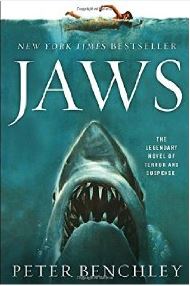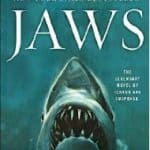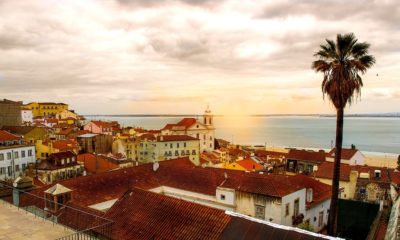Author Archives:Site Admin

27
JulMeet Libby
 Meet Libby.
Meet Libby.
What/Who is Libby?
Libby is a downloadable application, like Overdrive. You can use Libby to listen to audiobooks or read e-books on your phone or tablet.
You can use your library card to log-in and check-out books like you would with the Overdrive app.
Why would I want to use Libby?
Libby is more user-friendly than Overdrive.
If you have library cards from more than one library/network, Libby will keep all your checked out items in one place.
Libby can send your ebooks to your Kindle, if you prefer to read there.
You can add tags and categories to keep your reading lists organized, and Libby will keep track of your recent reading–if you want her to.
Are there any drawbacks with Libby?
Unfortunately, you are not able to stream videos with Libby, but that feature may be added soon.
Want to know more or download? Visit the website.

29
JunYou’re Gonna Need A Bigger Boat!
 It was one year after the release of the Steven Spielberg horror/thriller Jaws that Universal Studios Hollywood created their Jaws ride on their Studio or Backlot Tour. In that pre-digital age, the awesome special effects of the Jaws exhibit were animatronic Jaws, some foamy water and bright red blood, and a terrorizing tram ride along the shores of Amityville. Hardy riders watched the demise of a replication of the notorious boat, The Orca.
It was one year after the release of the Steven Spielberg horror/thriller Jaws that Universal Studios Hollywood created their Jaws ride on their Studio or Backlot Tour. In that pre-digital age, the awesome special effects of the Jaws exhibit were animatronic Jaws, some foamy water and bright red blood, and a terrorizing tram ride along the shores of Amityville. Hardy riders watched the demise of a replication of the notorious boat, The Orca.
For four decades the ride scared, thrilled and mesmerized millions of visitors, especially those who had seen the movie. And who hadn’t seen the movie? The Jaws sensation was perfected and redesigned at Universal Studios Florida and at Universal Studios Japan.
Over the years, however, children and teenagers were dragged on the spectacular ride (in the eyes of their parents and grandparents) and they found it lame and fake. Even those of us who rode again after the run of the century found it hokey and tired. The Jaws Attack ride went through several iterations across the world and was, finally, fully retired by 2012.
Author Peter Benchley was a 31-year old struggling journalist in 1971 when he wrote a novel about a shark that terrorized a community on Long Island, New York. He had become captivated by one particular shark hunter, Frank Mundus. Frank was a fisherman and a sensational boat captain and he capitalized on a fear, awe, and fascination with sharks. He led “Monster” fishing expeditions in hunt of sharks all for a pretty price. At the same time, he caught what might be the largest shark ever in 1964. Its weight was estimated to be 4,550 pounds.
Mundus was a colorful character who drank beer during the day, sported an earring in his ear, and skippered the Cricket and Cricket II off the coast of Long Island’s Montauk. Those of us who have seen Jaws know that this was the real life Quint, the passionate shark hunter that was written into Benchley’s book. No fish was too big for Mundus to tackle in 1964. He eventually became discouraged when his catch of a 3427 pound Great White on one of his sport fishing trips was disqualified. He moved to Hawaii but traveled back to New York in 2005 as the subject of a Discovery Channel documentary, Shark Hunter – Chasing the Great White. (The one-hour documentary can be seen in full on You Tube.) He died in 2008 in an airport in Hawaii, returning on yet again another trip to New York.
There is no doubt, then, that Mundus inspired Benchley’s book that was commissioned and then published by Doubleday in 1974. It was a sensational thriller, staying on the bestseller lists for 44 weeks. Of course, the rest is history when Benchley co-wrote the screenplay and a 30-year old Steven Spielberg directed.
In the early 90s, sharks had virtually disappeared in the waters off Montauk, assuredly the result of Mundus and others who followed him. Nearly 1000 sharks were caught each day off Long Island. Both Mundus and Benchley eventually came to regret spawning both the appeal of shark hunting and the fear of sharks that was invoked by their successes. Benchley followed the success of Jaws with The Deep in 1976 and The Island in 1979, both made into films but never with the success of Jaws. He wrote more novels and works of non-fiction about the oceans and seas, was the first host of Shark Week in 1994 and created Peter Benchley’s Amazon television show.
The producers of Jaws invented the summer blockbuster. Up until the summer of 1976, films very infrequently became huge successes. It helped that the beaches were open and the days were hot for swimming and Spielberg spent heavily on advertising and planned for simultaneous release of Jaws across many markets.
None of the three sequels reached the triumph of the original Jaws. Jaws 2, Jaws 3D and Jaws: The Revenge made money but never held the allure or achieved the success. The book and the movies all managed one thing, however. It kept people from going in the water. Beach attendance after the release of the first Jaws was at an all-time low. The fears experienced by millions of people was similar to that induced by Hitchcock’s movie Psycho in 1960.
Jaws is included on any number of “Best Film Ever” lists and there are few people who haven’t seen or heard about the film or the book. A 2007 documentary, The Shark is Still Working, studies the influences and power of the 1975 film. The images, let alone the impressionable music, conjure smiles, smirks and squeals from most of us. Richard Dreyfus, the young oceanographer was 29 when Jaws was released. Roy Schneider, police chief Brody, saw his first success in French Connection but had amazing and multiple successes in Jaws and Jaws 2.
Beloved (or hated) shark hunter Quint was played by Robert Shaw who died only four years after Jaws was released. Unlike Dreyfus, Spielberg, Williams and Schneider, whose careers exploded after the success of the movie, Jaws was one of Shaw’s last appearances. He also starred in Benchley’s The Deep in 1977, and died in Ireland of a heart attack at the age of 51 in 1979. Composer John Williams had already won an Academy Award for Fiddler on the Roof in 1971 but he won again for Jaws in 1976 and for Star Wars in 1977. Peter Benchley’s legacy of shark conservation and education lives on in the Peter Benchley Ocean Awards.
The Morrill Memorial Library has copies of all three of the Jaws films and Peter Benchley’s bestselling book. The Minuteman Library Network has many more. June 20, 2017 was the 42 anniversary of the film, Jaws, and sharks have been fascinating, terrifying and intriguing us for all forty-two years.
Charlotte Canelli is the library director of the Morrill Memorial Library in Norwood, Massachusetts. Read Charlotte’s column in the June 29th issue of the Norwood Transcript & Bulletin.

22
JunThe Word for “Potatoes”
 Much of my family history has been washed away on the river behind the soap mills in Rhode Island. That is where my grandparents worked, lived, and abandoned speaking Portuguese for English, and where they hoped that their children would learn English, too, but with a Rhode Island accent that misplaced “r’s”. They hoped that their children would learn math from strict nuns-turned-schoolteachers; that their children would one day have jobs better than their own. What my great grandparents had hoped for when they left the Azores was something better, but not for them.
Much of my family history has been washed away on the river behind the soap mills in Rhode Island. That is where my grandparents worked, lived, and abandoned speaking Portuguese for English, and where they hoped that their children would learn English, too, but with a Rhode Island accent that misplaced “r’s”. They hoped that their children would learn math from strict nuns-turned-schoolteachers; that their children would one day have jobs better than their own. What my great grandparents had hoped for when they left the Azores was something better, but not for them.
My family was one of the lucky ones, for the most part, and each generation was more well-educated, had better jobs, spoke better English (whatever that means), and some became so American that they actually spoke it much worse. As my grandparents passed away, I realized, as many people do when they lose the history that their parents and grandparents remembered, no matter how hazy their memories were, that I could not explain why growing up with chourico for breakfast or malasadas on Sundays seemed the pinnacle of Americanness. Nor could I understand how soaps in the shape of roses, or sailboats, or sunflowers, which all smelled how they looked–even the sailboats!–did not play such an important role in the homelife of my friends; they all bought boring, white soaps that smell nothing like how they looked.
I will not pretend that I was interested in the life that my family had left behind, at least until I was given the opportunity to go to Portugal, to write in some small apartment with an ocean view in Lisbon, and to eat the food of which my father had made his own versions–maybe to drink some of that sweet wine from Porto, too. I had been too focused on the future to think about how it was built on the possibility of someone else’s past. Regardless, and perhaps in spite of a long, willful ignorance of my family’s cultural heritage, I became curious about the language that sounded like it was Spanish whispered with a Russian accent. During my research, the colonial history of the country, the power it once had as an economic empire, and the current social and political progress it celebrates surprised me, for I held onto a belief that, since my family had left, it could never have been a wonderful place, let alone be one today. It was refreshing and empowering to find out how wrong an impression could be by questioning it and determining for myself what was and what was not true.
Much if not all of what I found was from books like Nobel Prize Laureate José Saramago’s Journey to Portugal, Paul Crowley’s Conquerors, or one of the travel books on Portugal (Lonely Planet, Rick Steve’s, and Fodor all have great editions), and I was lucky to be able to use the library’s subscription to Mango Languages so that I could brush up on my Portuguese before the trip. Of course, so much of tracing my family’s roots would have to happen on the winding, cobbled streets and in the coffee shops that brewed strong coffee, but the books gave me a head start, and it turned out that potash, the word my father had always used for potatoes, was wrong; it is actually batatas. Who would have thought?
Samuel Simas is the technology assistant at the Morrill Memorial library; he is a graduate student at the University of Rhode Island’s Graduate School of Library and Information Studies. Read Samuel’s column in the June 22nd issue of the Norwood Transcript & Bulletin.

15
JunMy Presidential Library
 I was in sixth grade when President John F. Kennedy was assassinated. My family lived in Berkeley, California. I was home ill that fateful day with yet another bout of chronic tonsillitis.
I was in sixth grade when President John F. Kennedy was assassinated. My family lived in Berkeley, California. I was home ill that fateful day with yet another bout of chronic tonsillitis.
As I watched morning television at 10:20 am with my 3-year old younger brother, KTVU (Oakland) interrupted Miss Nancy’s Romper Room. We heard shocking news that the President had been shot. (I lived on the West Coast. If you lived on the East Coast, it was 1:20 pm when Walter Cronkite interrupted the daytime soap opera, As the World Turns, to tell you this horrific news.)
I called to my mother and she rushed to the television from the kitchen. Shortly, we joined stunned neighbors gathering outside in the driveways.
This scene is as vivid as yesterday to me. My family had just moved from Boston a few years earlier in 1959. Ours was a fiercely democratic, union-loyal household – my step-father was secretary-treasurer of the local AFL-CIO and a member of the typographer’s executive council. When I was eight years old I stood on the downtown corner in Berkeley with my family and watched a hopeful John F. Kennedy waving to us from his motorcade as he cruised through town. I waved back and hollered with thousands of others along his route on Shattuck Avenue. Later that year, our family watched the 1960 presidential election returns early in the evening at dinner time. California time.
Although the actual election results were incredibly close (the tightest race since 1916), Kennedy was ahead early in the evening after the East Coast polls closed. Throughout the evening Nixon picked up votes in the Midwest and West Coast. California, in fact, voted for their hometown boy and Nixon picked up all 32 of my state’s electoral votes. San Francisco’s East Bay, however, went to Kennedy. My family was ecstatic with joy when we were told of his national victory the next morning.
It was just a few years later and the Kennedy years brutally ended.
We all were glued to the television throughout that weekend. JFK was killed on a Friday and President Lyndon Johnson declared the day of the funeral, Monday, a national day of mourning. Even as an 11-year old, I realized that the world had changed that fateful November.
A few months later, in the summer of 1964, my family had recently moved to the golden-hilled Bay Area suburbs. Parade Magazine featured a story on Jackie Kennedy who was beginning to fundraise for the JFK Presidential Library. The Parade weekly supplement was a favorite of mine; it arrived inside our weekend newspaper. Just weeks before he was assassinated, Kennedy had chosen a spot next to the Graduate School of Business in Cambridge overlooking the Charles River; the presidential library was going to be built on the campus of Harvard. Kennedy felt strongly that his personal effects should be included in the records of his presidency and for that reason “museum” would be added to the library name.
The tradition of official presidential libraries began with Franklin Roosevelt. They were and are part of the National Archives and Records Administration in the United States. Each president after FDR has had a presidential library built through a foundation. Today, there are thirteen in total (including Barack Obama’s which has begun its funding stage; it currently is administered by the Obama Foundation.)
After President Kennedy’s assassination, his family and friends were tasked with a building this memorial to JFK: the library. Mrs. Kennedy took charge and met with architects, many of those meetings in the Kennedy compound on the Cape. Jackie and others began the fundraising campaign. It was immediately successful due to the fact that the world was still mourning the president. Over $4.3 million was pledged within months. Large donations came from foundations and from organizations in other countries. Thousands more were received in small donations from the public.
That summer of 1964, I read Jackie Kennedy’s appeal for her husband’s presidential library in Parade magazine. I decided to hold a car wash to raise some money to donate to the cause. I enlisted skeptical neighborhood girlfriends, got permission from the gas station at the end of my street (to use their water, space and hose), made some signs, gathered some sponges and soap, and washed cars for several hours during the morning and afternoon. In the end, I sent $11.45 off to Mrs. Kennedy with a personal note hoping for the success of the library. It included the passion of my own young grief for President Kennedy.
By December of 1964, just one year after JFK was killed, a $10 million goal was reached and architect I. M. Pei had been personally chosen by Mrs. Kennedy to design the library. After only one more year, $20 million had been pledged.
By the early 70s, however, Robert Kennedy, President of the Library Corporation had been assassinated and the Harvard location in Cambridge was found to be a troublesome spot due to some squabbles over MBTA land and the hope of combining forces with the JFK School of Government. Costs had risen and Cambridge residents and officials were concerned about traffic in the area. Architect Pei was asked to abandon his choice for stone for the alternative concrete to help cut the rising costs.
Finally, in 1977, plans at Harvard were abandoned and the present Columbia Heights site was chosen and groundbreaking finally began. The costs were kept to $20.8 million, thanks to Pei’s changes, and the building was completed in 1979, built from concrete and glass overlooking Boston and the ocean. Caroline, John Jr., President Jimmy Carter and Senator Edward Kennedy attended the dedication.
Today, in 2017, the Library is joined by the Massachusetts State Archives (1985) and the Edward Kennedy Institute for the United States Senate (2015). Columbia Point is also home to the University of Massachusetts – Boston.
Normally, the Morrill Memorial Library is closed one Friday each June when library staff attend workshops and/or hire a speaker for an entire day of enrichment for the library staff. This year for our staff development day we were closed for the new carpeting project. We spent three days last week visiting other libraries and attending a workshop at the Minuteman Library Network training center. On the last day, Friday, June 10th we toured the JFK Presidential Library and Museum and his 100th birthday exhibit. We ended the day at the State Archives and Commonwealth Museum.
It was terrific to take the time with our tour guide to learn more about the JFK library. I asked a tour guide if perhaps letters to Mrs. Kennedy were saved in the archives and if perhaps the donations were recorded. He suggested that I could to write to the librarians and archivists. It certainly would be thrilling to see my 11-year old handwriting and my personal note to Jackie Kennedy noting my own contribution to this important library.
The Morrill Memorial Library has passes to both the JFK Library and Museum and the Edward Kennedy Institute. Admission is free to the Archives and Commonwealth Museum. All three share a parking lot. They are so very worthy of your visit.
Charlotte Canelli is the library director of the Morrill Memorial Library in Norwood, Massachusetts. Read Charlotte’s column in the June 15th issue of the Norwood Transcript & Bulletin.

13
JunStuck on a Desert Island
 For our 6th annual library essay contest the topic was “If You Were Stuck on a Desert Island, What Book Would You Bring and Why?” Yes, this is an oft used question but we had as many different answers as sand upon the shore.
For our 6th annual library essay contest the topic was “If You Were Stuck on a Desert Island, What Book Would You Bring and Why?” Yes, this is an oft used question but we had as many different answers as sand upon the shore.
With over 100 entries, 14 judges, and a whole lot of fabulously creative writing, the selection process was anything but easy. That said, congratulations go to the follow winners, most of whom read their work at our celebration on May 22nd, from 7-9 pm:
Level 1 (Grade 3-4): Melanie Clark, First Place; Charlotte Martino, Second Place; Partha Jammalamadaka, Third Place; Sysille Eaton, Benoit Gebbie, Devin Lemorticelli, Nicole Martino and Kyra Walsh, Honorable Mentions
Level 2 (Grade 5-8): Alyssa Lahaise, First Place; Joy Xu-Allan, Second Place; Trevor Brown, Third Place; Serena Elias, Jason Le and Haniya Sperling, Honorable Mentions
Level 3 (Grade 9-Adult): Mary Erickson, First Place; Anthony Cavanaugh, Second Place; and Joseph Gallant, Third Place.
Now you might be wondering what books were chosen and why? Of course we had the popular books by J.K. Rowling, Jeff Kinney and Rick Riordan. Still, it was the most creative essays that rose to the top. Take Melanie Clark’s for example. She opened her essay by imagining that her island life began after “something big hits the hull of the boat. The boat starts to sink, you quickly put on a life, vest, grab your book, jump off the boat, and swim to the deserted island.” On the way Clark grabbed her Harry Potter and The Prisoner of Azkaban because it was a “page turner” and you don’t want to be bored when you’re hanging out on an island for a while.
For Charlotte Martino El Deafo by Cece Bell was an obvious choice. She thought this book would give her ideas of things to do. “For example I can pretend to be a superhero like Cece, and I can build friends out of sand and water because Cece had a lot of friends in the book.” As Anthony Cavanaugh wrote about The Mark of Athena, it might be helpful to have a Roman or Greek hero in your back pocket. “They must fight to survive using the many powers and skills that they have received from their unearthly parents.” For other participants like Partha Jammalamadaka, it came down to the page count and the sense of humor with Diary of the Wimpy Kid: Double Down. Who wouldn’t want a laugh or two when hanging out by your lonesome on an island?
And speaking of humor, others won the hearts of the judges through their funny ideas. Benoit Gebbie decided after finishing Ready Freddy that he would use some of the pages from the back of the book to make origami creations like “paper shovels, paper boats and paper hats.” While this idea might give a librarian a nightmare or two (ripped books!), one can only read a book so many times. Ultimately Jason Le decided to bring Jedi Academy but he reassured his readers that being stuck on a desert island was “impossible because I’m awesome.” Ha!
Alyssa Lahaise had an out of the box idea. She’d cart along her very own book, aptly named Mr. Book. “Mr. Book would have a durable, black cover so that nothing could destroy him. He would have chapters on building fires, hunting and gathering food, constructing or finding shelter, and calling for help.” All of this would be helpful because as Lahaise claimed, “Honestly, the first thing I would probably do is freak out.”
The pragmatists also had their say. Devin Lemorticelli brought along the Guiness Book of World Records of 2005. Why not? After all, he’d have lots of time to pour over all those stats. Likewise, Nicole Martino thought her social studies book Harcourt Horizons States and Regions would give her “something to learn every day.” Plus “this book tells you how to make a soddie which is a home that the pioneers made.” With Who Was King Tut? Kyra Walsh explained “what the Egyptians did to survive in the desert” and Sysille Eaton wanted to tote Magic Under the Stars since the main character, Shannon, “loves camping as much as I do.”
According to Joseph Gallant, We Seven was a must. If the Mercury astronauts could endure life in cramped one-man capsules, Gallant could handle life among the palm trees. Of course, no one could go wrong with Trevor Brown’s choice of The Legend of Robinson Crusoe. After all, he had to “build a fort that could withstand weather and animals for about 27 years” before Crusoe was rescued. Now that’s resourceful thinking.
Finally, there were the books selected for inspiration alone. Haniya Sperling suggested The Wizard of Oz since “its many lovable characters will capture the heart of everybody who reads this enjoyable tale.” Serena Elias thought Dolphin Tale was inspiring because “it tells people never give up, because if you give up you will never know what you can achieve.” Likewise Egg and Spoon was a hit with Joy Xu-Allan. The story was “so entrancing that even if it was my tenth time reading it, I wouldn’t be bored.” According to the first place winner, Mary Erickson, Walden by Henry David Thoreau would bring the most solace. As she wrote, “When on a desert island, there is not contact with the rest of the world, so one needs to know how to live simply and co-exist with nature.”
Certainly, our librarians hope that none of our readers are stuck on a desert island for too long this summer but, if you are, you will have some good books to choose from while sitting in your beach chair.
Nancy Ling is the Outreach Librarian at the Morrill Memorial Library in Norwood, Massachusetts. Read Nancy’s column in the June 8th issue of the Norwood Transcript and Bulletin.
